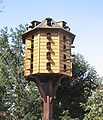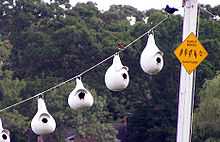Nest box

A nest box, also spelled nestbox, is a man-made enclosure provided for animals to nest in. Nest boxes are most frequently utilized for birds, in which case they are also called birdhouses, but some mammalian species may also use them. Placing nestboxes or roosting boxes may also be used to help maintain populations of particular species in an area. The nest box was invented by the British conservationist Charles Waterton in the early 19th century to encourage more birdlife on the wildfowl and nature reserve he set up on his estate.[1]
Construction
General construction

Nest boxes are usually wooden, though some for birds are made from a mixture of wood and concrete, called woodcrete. Metal nest boxes are also marketed, but these are generally unsuitable for outdoor use, as they can overheat in sun, and provide no insulation to cold.
Many nest boxes are cuboid and have a sloping roof, with a hinged top, side or front to provide access for cleaning, bird ringing or, when used for domesticated species, to give the breeder access to the young. Boxes may either have an entrance hole or be open-fronted. Some nest boxes can be highly decorated and complex, sometimes mimicking human houses or other structures. They may also contain nest box cameras so that use of, and activity within, the box can be monitored.
Bird nest construction

One of the most important aspects of a nest box determining the exact bird species that will use it is the diameter of the opening. Most small birds do not like the opening to be too large to prevent other birds from raiding it, so having the size of the opening exactly right increases the chance that the intented specific bird species will use it. For example, in European countries, an opening of 2,5 cm in diameter will attract Poecile palustris, Poecile montanus; an opening of 2,8 cm in diameter will attract Ficedula hypoleuca, and an opening of 3 cm in diameter will attract Parus major, Passer montanus, an opening of 3 cm in diameter will attract Passer domesticus[2]
Another aspect that determines the bird species that will use it is the size of the nest box itself. Different sizes suit different species of birds; for example, very small boxes attract wrens and treecreepers and very large ones may attract ducks and owls. Seasonally removing old nest material and parasites is important if they are to be successfully re-used.
Then, the type of material used is also of importance. Blue Tits, Great Tits and Tree Sparrows have been shown to prefer woodcrete boxes rather than wooden ones. Birds nesting in woodcrete sites had earlier clutches, a shorter incubation period, and more reproductive success, perhaps because the synthetic nests were warmer than their wooden counterparts.[3]Finally, the placement of the nest box obviously is also an very important aspect. Some birds prefer their nest box to be at a certain altitude at the tree, some birds (as ducks) them to be very low or even at ground level. Also the orientation to the sun is of importance (south facing ones -in northern hemispheres- tend to be warmer than south-facing ones), ...
Bat nest construction

Bat boxes differ from bird nest-boxes in typical design, with the larger opening on the underside of the box, and are more often referred to as roost boxes, although in regards to the rearing of young, they serve the same purpose. Threatened bat species can be locally supported with the provision of appropriately placed bat-boxes. Bats are a means of natural mosquito and insect control in some parts of the world. A single bat can eat 500 to 1,000 mosquitoes per night[4] as well as other insect pests.[5] Directions for making the open bottom bat houses for small and large colonies,[6][7] as well as locations to purchase them are available on the internet.[8] Bat houses are an ecologically friendly way of controlling mosquitoes as pesticides mostly kill the mosquitoes' predators rather than mosquitoes.[7] Australian Bat Box projects have been running for over 12 years in particular at the Organ Pipes National Park. Currently there are 42 roost boxes using the "Stebbings Design" which have peaked at 280 bats roosting in them. The biggest problem with roosting boxes of any kind is the ongoing maintenance; problems include boxes falling down, wood deteriorating, and pests such as ants, the occasional rat, possums, and spiders.
Other creatures

Nest boxes are marketed not only for birds and bats, but also for butterflies[9] and other mammals, especially arboreal ones such as squirrels and opossums. Depending on the animal, these boxes are used for roosting,[citation needed] breeding,[citation needed] or both. Or, as in the case with butterflies, hibernation.[9] Wasps may build their nests inside a nest box intended for other animals, and may exclude the intended species.
Birdhouses
-

-
-
-

-
Typical nest boxes in the UK
-
Multiple nest box and feeding station
-
Holk uppsatt för vetenskaplig studie.
-

Californien.
-
Norway.
-

-

-
-

See also
- Biological pest control: birds can help controlling pests in agriculture; section also details the planting of food crops for birds
References
- ↑ "Charles Waterton (1782 - 1865)". Retrieved 2013-12-16.
- ↑ HDRA encyclopedia of organic gardening by Pauline Spears
- ↑ García-Navas, Vicente; Arroyo, Luis; Sanz, Juan José; Díaz, Mario (2008). "Effect of nestbox type on occupancy and breeding biology of tree sparrows Passer montanus in central Spain" (PDF). Ibis 150: 356–364. doi:10.1111/j.1474-919X.2008.00799.x.
- ↑ "Bats and Bat Houses". Mosquito Abatement District-Davis Headquarters, Kaysville, UT. Retrieved 2007-11-17.
- ↑ McAvoy, Gene. "Hendry County Horticulture News: Bats Eat Mosquitoes as Well as Numerous Garden Pests". University of Florida; Cooperative Extension Service. Retrieved 2007-11-17.
- ↑ "Single chamber bat house (wall mounted)". Bat Conservation International. Archived from the original on 2007-10-31. Retrieved 2007-11-17.
- ↑ 7.0 7.1 Brown, Carla. "Why I Built A Bat House". National Wildlife Federation. Retrieved 2007-11-17.
- ↑ Boleky, Vaughan (2005-2006). "Why Are Bat Houses Important?". Organization for Bat Conservation. Archived from the original on 2007-11-10. Retrieved 2007-11-17.
- ↑ 9.0 9.1 Nina Bergström. "Fixa fint för fjärilarna", Expressen, 16 June 2011. Retrieved 28 June 2011. (In Swedish)
External links
![]() Media related to Birdhouses at Wikimedia Commons
Media related to Birdhouses at Wikimedia Commons
- Nest box page from the Royal Society for the Protection of Birds.
- Birds Australia Information Sheet 5: Nestboxes for Natives PDF download
- Rob McDonald, "Birdhouses," Southern Spaces, 12 July 2006. http://southernspaces.org/2006/birdhouses








